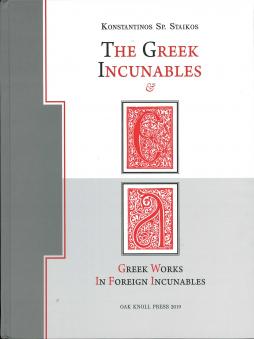
- Description
- New Castle, Delaware: Oak Knoll Press, 2019 280x215 mm. xv, 248. Ill. Hardcover.
- language
- English

The Greek Incunables & Greek Works in Foreign Incunables
Konstantinos Sp. Staikos
The Greek Incunables and Greek Works in Foreign Incunables aims to delineate and present the corpus of Greek books printed until 1501, with a special focus on those works published in the original. This is to our knowledge the first systematic presentation of the Greek books released in the incunabular period. Printing in Greek posed challenges in the early printing era, both because producing reliable editions and translations was a very laborious task and due of the need to design and cut special typeface complete with accents and breathing marks. Tying in with the author's earlier works such as Charta of Greek Printing, the book places the publication of Greek books in Italy and other printing centres in Europe within the context of Renaissance humanism, and the desire to recover the works of Greek and Roman antiquity. The first chapter concisely describes the context of production of those editions in the second half of the 15th century, with emphasis on the place of classical languages in Renaissance education and the crucial work of Byzantine scholar Emmanuel Chrysoloras in Italy. At the same time it discusses the early translations of classical works into Latin by Greek and Italian scholars under the auspices of Pope Nicholas V in the mid-15th century, and emphasizes the link between the demand for printed books, specifically dictionaries and grammars, and humanist education. An overview of the printing shops of Italy is provided, with a focus on the pioneers of typography such as Pannartz, Sweynheim, Ulrich Han and Aldus Manutius, and humanist scholars like Giovanni Andrea de Bussi, cardinal Bessarion and others. There follows a succinct presentation of the technical challenges met with by early printers, the layout of the first bilingual books, and the design of Greek founts. Naturally, several works of Greek literature circulated first in Latin or in other languages. Thus the second part of the work is a list of Greek texts published in translation, either as stand-alone works or as part of incunabular collections on morality, philosophy, poetry etc. The third and main section of the book is a catalogue of the approximately eighty editions which circulated in Greek from c.1469 to 1501, with an entry dedicated to each, describing the contents and the history of that book's creation. This catalogue includes works released independently as well as excerpts of Greek texts (for example, Gorgias of Plato cited in Aulus Gellius's Noctes) and trial sheets such as those produced for the Deipnosophists and Manutius's project of the Polyglot Bible. Lavishly illustrated throughout with pages of those first editions and other material, The Greek Incunables enables readers to visually appreciate the work of the pioneers of typography and come into contact with the world of early printing.
